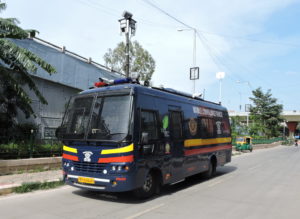Head-mounted Voice Activated, Gesture Controlled Wearable Accessory for Mobile Devices
Introduction
The embedded world is witnessing a proliferation of wearable devices in a multitude of domains including, education, entertainment, communication and navigation, healthcare, industrial and more. Mistral has been in the wearable domain for more than a decade designing and deploying several successful designs for our wearable OEM partners.
The Head-mounted wearable device is a voice-activated and gesture-controlled smart device designed to function as an accessory to the smartphone. The headset device hosts a wide range of futuristic features, which will function as an extension of the smartphone to which it is connected enabling hands-free operation. The device can revolutionise applications such as Warehouse Management, Field Service, Manufacturing & Transportation by enhancing the efficiency of people and processes. 
This case study brings out Mistral’s expertise in the wearable domain, conceptualising, designing and developing powerful, low power, small form factor, rugged devices that host trending and futuristic features and technologies. This case study also showcases Mistral’s proficiency in implementing Speech Recognition, Gesture Control, Noise Cancellation and UI/UX application development for wearable applications.
The Customer
The customer is a leading product developer and solution provider for wearable devices with enhanced visual, verbal, audio and head-gesture command capabilities for the military, consumer, or industrial applications.
The Requirement
The customer wanted to build a light-weight, next-generation ultra-lightweight wearable accessory for mobile devices. The design was perceived as a head-mounted micro smart screen that functions as an accessory to the smartphone to complement/extend the features of a Smartphone by enabling hands-free operation.
During the requirement analysis, the customer recommended using their own micro-display and noise cancellation technology. The customer wanted a low-power, ultra-small form-factor design that integrates advanced voice/gesture recognition technology, allowing users to control their smartphones for various field applications in an industrial scenario.
Solution Provided
Mistral conceptualised and designed a wired ultra-light wearable accessory based on a powerful microcontroller and incorporating a 12 MP camera. The high-resolution USB camera can be accessed using a custom camera application on the host smartphone.
The solution includes,
- Near Eye Display
- Array microphones for noise cancellation
- 9-axis MEMS sensors
- Stereo audio speakers
- ALS [Ambient light sensors]
Mistral also developed the complete embedded microcontroller firmware for the product and developed an application that runs on an Android smartphone to use the features of the headset. The Smart Application Launcher is designed with a multitude of options that can be launched and controlled by voice commands. We also came up with a complete diagnostics firmware and software that’s required for mass production of the headset.
Major features and capabilities of the device includes,
- The headset device is designed to support high-resolution USB camera which can be accessed by the Camera Application on host smartphone. The camera inbuilt into the headset is speech enabled. The Camera Application is designed to perform various operations using speech commands, viz., camera preview at different resolutions [VGA, HD, Full-HD], Taking Pictures, Videos, Zoom-in/Zoom-out, Barcode Scanning, and more.
- Users can use voice commands to launch Gallery Application and use head-gesture to navigate, highlight, view and zoom into pictures in the “Image Gallery” from Device’s Application Launcher.
- The device is enabled with a Video Conferencing Application developed based on the popular Zoom SDK. This application is integrated with the device to support speech and head gesture-based controls to manage Zoom meetings. The Video Conferencing Application is enabled with Speech commands that will be handy during the Video Conferencing.
- The ‘Device Settings’ application is designed to be controlled by speech and head-gestures. It allows to change the settings of headset device.
- Another key feature is the Self-training Application implemented in the device. This application helps first-time users adopt the system quickly into their work routine. The prime focus of this application is to let the user get familiar with basic functions and its usage including basic speech commands, head gesture in Icon mode and head gesture on mouse cursor/pointer mode.
Read the full case study to know more about key achievements of the project and how the customer is benefitted out of it.





